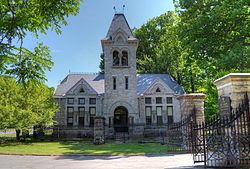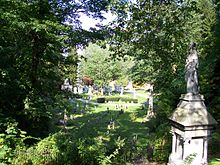Mount Hope Cemetery (Rochester)
| Mount Hope Cemetery | |
|---|---|
 Gate House of Mount Hope Cemetery | |
 | |
| Details | |
| Established | 1838 |
| Location | |
| Country | USA |
| Coordinates | 43°07′42″N 77°37′17″W / 43.12833°N 77.62139°W |
| Type | public |
| Owned by | City of Rochester |
| Size | 196 acres (793,000 m²) |
| No. of graves | 350,000 |
| Find a Grave | Find-a-Grave |
| The Political Graveyard | The Political Graveyard |
Mount Hope Cemetery in Rochester, New York, founded in 1838, is one of the United States' first municipal rural cemeteries. Situated on 196 acres (793,000 m²) (0.3 square miles) of land adjacent to the University of Rochester on Mount Hope Avenue, the cemetery is the permanent resting place of over 350,000 people. The annual growth rate of this cemetery is 500-600 burials per year. Mount Hope also contains the ruins of a now outdated catacomb system, most notably with its sealed entrance on the east-facing drumlin upon entering the cemetery from the north. Its alternative entrance (also sealed) can be found in the Sunken Garden of Warner Castle across Mt. Hope Avenue.
Geology of Mount Hope
About 12,000 to 14,000 years ago, Mount Hope was covered with ice one to two miles thick. As the glacier receded, cracks appeared in the ice, and these crevasses became rivers of water and gravel. When the miles-high ice sheets finally melted, these river beds were left as ridges created from all the rock and rubble that had been deposited by the flowing river. In geological terms, these ridges are called eskers. One such esker snakes its way through much of Mount Hope Cemetery. The Seneca Indians used it as a trail from the Bristol Hills south of Rochester to Lake Ontario on the city's northern border. For them, it provided a continuous high path through the moraine and visibility of valleys around them. Today, this esker is a principal vehicular lane through the cemetery and is called Indian Trail Avenue.
Notable burials

- Samuel G. Andrews
- Susan B. Anthony
- Charles S. Baker
- Johnny Baker
- John Jacob Bausch
- Hartwell Carver
- Jonathan Child
- Emma Lampert Cooper
- Adelaide Crapsey
- Algernon Crapsey
- Edward R. Crone[disambiguation needed]
- Abraham De Mallie
- Isaac De Mallie
- Frederick Douglass
- Thomas B. Dunn
- George Ellwanger
- Elizabeth Hollister Frost
- Frank Gannett
- Morton Goldberg
- Seth Green
- James Hard
- Myron Holley
- Thomas Kempshall
- Henry Lomb
- General E.G. Marshall
- Vincent Mathews
- Alexander Millener
- Lewis Henry Morgan
- Anna Murray-Douglass
- Jacob Myers
- Henry O'Reilly
- Amy and Isaac Post
- Charles Mulford Robinson
- Nathaniel Rochester
- Thomas H. Rochester
- Abraham M. Schermerhorn
- George B. Selden
- Henry R. Selden
- Hiram Sibley
- Elijah F. Smith
- Fletcher Steele
- Margaret Woodbury Strong
- Theron R. Strong
- Samuel R. Thayer
- James Vick
- Lillian Wald
- Henry Augustus Ward
- Don Alonzo Watson
- Jessica M. Weis
- George Whipple
- Frederick Whittlesey
- Abel Carter Wilder
- Owens Shepard
- Nick Tahou
- Mykola Bezwerchyj
General Elwell Stephen Otis was originally interred at Mount Hope before being removed to Arlington National Cemetery. Notable cremations at Mount Hope include Blanche Stuart Scott and George Eastman.
Friends of Mount Hope
The Friends of Mount Hope Cemetery is a non-profit organization of volunteers founded in 1980 to restore, preserve, and encourage public use and enjoyment of this unique historical treasure.
The Friends of Mount Hope have been instrumental in completing a number of improvements throughout the cemetery. Projects such as the restoration of the 1872 Moorish Revival gazebo, upgrades to the 1874 High Victorian Gothic gatehouse, repair and uprighting of stones, monuments and obelisks, and the rebuilding of the cobblestone road (Ravine Avenue) have been completed.
They even allow volunteers to take part in the restoration with the "Adopt-A-Plot" program. Each year volunteers willing to reclaim and beautify old family plots help keep the rich history of this cemetery alive for future generations.
If you plan on visiting this unique landmark you can stop at the gatehouse where a free pocket guide which includes a map of Mount Hope Cemetery is available.
Mount Hope Historians

Richard O. Reisem
Richard Reisem is a Rochester resident and the cemetery's unofficial historian. He has written two books about the history of the cemetery. The photographs in both books were taken by the late Frank Gillespie. Reisem has written more than a dozen other books covering Rochester and New York state history and architecture. He is a trustee of the Friends of Mount Hope Cemetery and sometimes provides guided tours.
Mount Hope Cemetery: America's First Municipal Cemetery
The Landmark Society of Western New York published a coffee table book, now out of print, about the cemetery. Tales of heroism, tragedy, romance, torture, achievement, suicide, adventure, pageantry, intrigue, embezzlement, weird happenings, fame, and even cannibalism are interwoven with rich, moody large duotone photographs of Rochester's world-famous cemetery.
Buried Treasures in Mount Hope Cemetery, Rochester, New York: A Pictorial Field Guide
Also by Richard O. Reisem with photographs by Frank Gillespie, "Buried Treasures" is a 176 page spiral bound pocket guide to the cemetery which contains short biographies of 500 notable persons interred therein, along with burial locations, maps, gravestone photographs and a brief guide to Victorian funerary symbolism.
